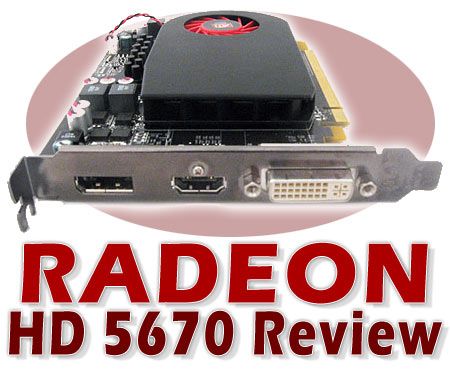ATI Radeon HD 5670: DirectX 11 For $99
Introduction
Up until this point, ATI's Radeon HD 5000-series GPUs have really raised the bar on what we expected from the next generation of video cards. The Radeon HD 5870 offers roughly the same performance seen on the previous flagship dual-GPU Radeon HD 4870 X2. The Radeon HD 5770 serves up about the same performance as the aging (but still powerful) Radeon HD 4870. The Radeon HD 5750 delivers similar performance as the mainstream-friendly Radeon HD 4850.
Given such a promising lead-up, it's hard not to have high expectations for ATI's emerging Radeon HD 5670. Dare we hope that it give us performance on par with the Radeon HD 4770, a card that tantalized us with 40nm under $100, and then broke the hearts of amped-up gamers after suffering poor availability?
With a suggested retail price of $99, the Radeon HD 5670 being evaluated today needs to be powerful if it's going to offer value in the most competitive price segment known to the world of discrete GPUs. After all, ATI's Radeon HD 5670 will be doing battle against the less-expensive GeForce 9600 GT, the somewhat more modern GeForce GT 240, and Nvidia's aging GeForce 9800 GT. Not only that, but the card will also have to stave off old favorites, like the existing Radeon HD 4770, GeForce GTS 250, and Radeon HD 4850 models, all of which can be found as low as $110 online (sometimes less, if you're lucky).
Clearly, the Radeon HD 5670 has more worthy opponents than its high-end 5800- and 5700-series predecessors had to fight off when they launched. Of course, this story is about more than just raw benchmark results. AMD is also coming to the table with DirectX 11 support and a handful of value-adds, like Eyefinity multi-display output connectivity.
Saddled with the successes of the Radeon HD 5800- and 5700-series cards, our sample Radeon HD 5670 has some big shoes to fill. Let's take a peek under the hood to see what sort of hardware with which we're working.
Get Tom's Hardware's best news and in-depth reviews, straight to your inbox.
Don Woligroski was a former senior hardware editor for Tom's Hardware. He has covered a wide range of PC hardware topics, including CPUs, GPUs, system building, and emerging technologies.
-
amdfangirl 4800x900? Are you serious?Reply
Otherwise, great review. Just curious, are you going to make Flash 10.1 playback a benchmark? I'm just interested. -
noob2222 If it weren't for the 4770, this would be priced decently, at the same price it kills the 240. If they were to lower the price to $80 for the 5670, the 240 would get the dumb buy of the year award. IMO $90 would be about right, $80 is definatly too cheap.Reply
Here it will have to compete against the similarly-performing $80 GeForce 9600 GT
... wrong. it won crysis, was close in far cry2 and Hawx. It was slaughtered in the rest of the games by the 5670.
-
notty22 ..................Radeon HD 5670 Radeon HD 4770Reply
Shader Processors 400 640
Texture Units: 20 32
Color ROPs: 8 16
Those numbers against the 4770 show, a crippled card. Is this to leave something in the cupboard for the next generation ?
Just meh, no reason for this card to exist at all.
-
belial2k I think the points made here about the pricing could be made about the entire 5xxx series. At no point in the entire line is there a GOOD value. Everything can be beaten in price/ performance by previous generation cards or combination of cards...even the 5870 loses badly to two 4890s for less money. The only thing they have going for them is DX11 and eyefinity, which for most gamers are rather questionable "value" adds because of the huge hit DX11 gives framerates and the 3 monitors needed for eyefinity. All these cards need to come down in price before they become smart price/performance buys.Reply -
duckmanx88 notty22Just meh, no reason for this card to exist at all.Reply
low price point, low power consumption, and extremely close to the 9800GT in performance. Plenty of reasons to like this card. especially for a casual Sims or Torchlight gamer.
-
cleeve noob2222It was slaughtered in the rest of the games by the 5670.Reply
"Slaughtered". +1 for hyperbole! -
noob2222 Cleeve"Slaughtered". +1 for hyperbole!What would you call 12-20% faster across the board?Reply
oh, right, "similar" noting like the pot calling the kettle black huh. -
Otus 4850 and 4770 will be out soon and prices for what units are left will probably rise in price. There's probably room for price cuts for 5670 at aReply
